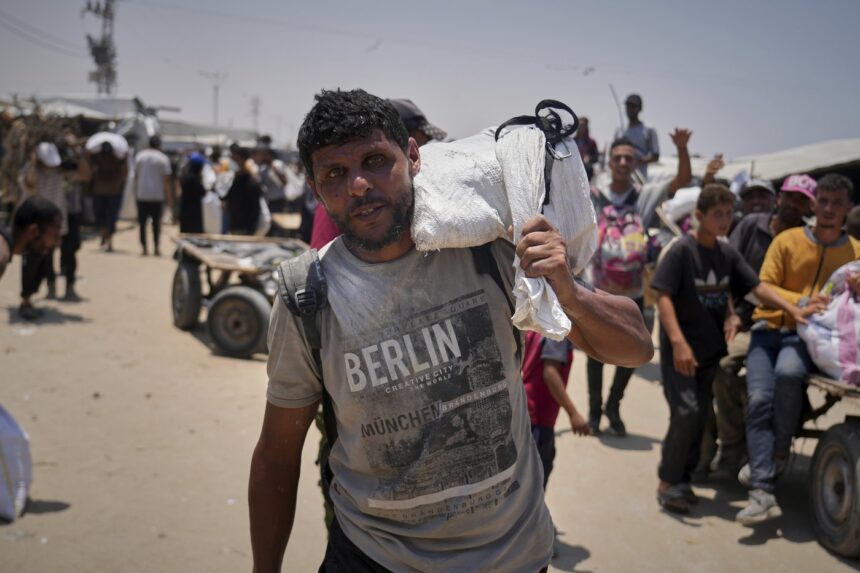Each morning as the sun rises over the bombed-out landscape of northern Gaza, Yasmin Mahmoud calculates the risk. The 32-year-old mother of three must decide whether today is a day to brave the desperate scramble for food or keep her children home, hungry but safe from the gunfire that regularly erupts around aid distribution points.
“We wake up wondering if this is the day we’ll eat or the day we’ll die trying,” Yasmin told me during my recent reporting trip to Gaza’s devastated northern region. Standing in the rubble of what was once her neighborhood grocery, she described watching two neighbors shot dead last week while attempting to reach a food distribution truck.
The humanitarian catastrophe unfolding in Gaza has reached unprecedented levels in June 2025, with the UN World Food Programme now classifying 98% of Gaza’s population as food insecure. The organization’s latest assessment concludes that famine conditions have solidified across northern Gaza and are rapidly spreading southward.
Yesterday, Israeli forces fired on a crowd attempting to reach an aid convoy near Jabalia, killing seven civilians and wounding dozens more, according to Gaza health officials. The Israeli military stated that “warning shots were fired after the organized distribution broke down,” though multiple eyewitnesses described direct fire into crowds of unarmed civilians.
The deadly incident is far from isolated. Data compiled by Médecins Sans Frontières shows that at least 86 Palestinians have been killed near aid distribution points since May, with hundreds more wounded. The organization’s field coordinator, Dr. Sophie Becker, described the situation as “a manufactured starvation event with no parallel in modern humanitarian emergencies.”
According to the latest UNRWA figures, food supplies reaching Gaza have dropped to just 17% of pre-war levels. The reduction comes despite multiple UN Security Council resolutions calling for unimpeded humanitarian access. The scarcity has transformed food distribution points into scenes of chaos and desperation.
“People are willing to risk everything for a bag of flour,” said Ibrahim Khalil, 45, who I met at Al-Shifa Hospital while he received treatment for a gunshot wound to his leg, sustained during an attempt to reach food trucks. “We have become animals fighting over crumbs while the world watches.”
The physical infrastructure for food distribution has largely collapsed. Since March, five of Gaza’s seven remaining functional bakeries have been destroyed in airstrikes. The Israeli military claims these facilities were being used by Hamas operatives, allegations that bakery operators and international observers dispute.
For Gazan families, the daily calculation involves impossible choices. Mohammed al-Bakri, a former university professor now living in a makeshift tent with his extended family of eleven, described their rotation system: “We send different family members each day to different distribution points. Whoever returns with food is celebrated. Those who don’t return—” he paused, unable to complete the sentence.
International aid organizations face their own deadly calculations. Three World Food Programme staff members have been killed since April while attempting to coordinate distributions. The organization’s regional director told a Brussels press conference last week that “coordinated aid delivery has become nearly impossible under current security conditions.”
The UN Office for the Coordination of Humanitarian Affairs (OCHA) estimates that Gaza’s population now needs approximately 300 trucks of food daily to meet basic nutritional requirements. In the past week, an average of 22 trucks have entered daily, with less than half reaching northern Gaza where needs are most acute.
Israeli defense officials maintain that security protocols at crossings are necessary to prevent weapons smuggling. “We are working to balance legitimate security concerns with humanitarian needs,” said a spokesperson for COGAT, the Israeli defense agency coordinating civilian affairs in Palestinian territories. However, a confidential assessment from the International Committee of the Red Cross, which I obtained during my reporting, concluded that “current inspection protocols go far beyond security necessity and constitute collective punishment.”
The consequences of food scarcity extend beyond hunger. Gaza’s healthcare system, already crippled by 21 months of conflict, now reports a surge in malnutrition-related illnesses. At Al-Awda Hospital in northern Gaza, pediatrician Dr. Nour Hashem showed me a ward filled with children suffering from severe acute malnutrition.
“We’re seeing diseases that had been eradicated decades ago,” Dr. Hashem explained, pointing to a six-month-old with marasmus, a severe form of protein-energy malnutrition. “And we have almost no therapeutic feeding supplies to treat them.”
Water scarcity compounds the crisis. According to Oxfam’s latest field assessment, 89% of Gaza’s remaining population lacks access to clean drinking water. Most functioning wells operate on minimal fuel, providing brackish water for just hours daily. The resulting dehydration accelerates the impact of malnutrition.
For those desperate enough to seek food at distribution points, the journey itself has become a gauntlet. Satellite imagery analyzed by Human Rights Watch shows that 83% of Gaza’s roads are now impassable due to bombing damage or military checkpoints. This forces civilians to walk miles through exposed areas, often under surveillance drones and within range of sniper positions.
“They know exactly when the food trucks are coming,” said Fatima Zayed, 62, who showed me her schedule of attempting food collection at different hours to avoid the most dangerous periods. “The most desperate go first, usually young men. We wait to see who gets shot before deciding if it’s worth trying ourselves.”
International diplomatic efforts to address the crisis have repeatedly faltered. Last month’s U.S.-backed proposal for a humanitarian pause collapsed when negotiators failed to agree on distribution mechanisms. Meanwhile, regional powers continue providing conditional aid that often doesn’t reach those most in need.
As the sun sets over Gaza City, Yasmin Mahmoud prepares her children for another hungry night. Tomorrow, she explains, her brother-in-law will attempt the journey to a rumored food distribution point near Beach Camp. She shows me the family’s remaining food: half a cup of rice and some salt.
“We keep hearing about international law, about humanity,” she says, tucking her youngest child into a makeshift bed. “But here, there is only survival or death. Nothing in between.”






